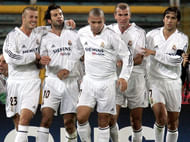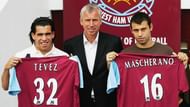As we inch closer to the end of another year, and Santa makes his way back to the North Pole, it is almost impossible to not get caught up in the festive spirit of it all. For football fans the world over, the countdown to another year is filled with even more promise and intrigue. Not least because when that clock strikes 12 at midnight, the January transfer window beckons.
As the rumour mills rush into overdrive and start quoting ridiculous amounts of money left, right and centre, you get to thinking. How did all this get started? What was it like, 50 years earlier, perhaps, to be chasing after the best players in the world? Did the money involved shock the fans to their senses, or did they let it wash over them – like we do – with an air of inevitability? As football rapidly became the most lucrative of businesses, how did the agents, with their talk of third-party ownership and bigger contracts, become such an integral part of the game?
And, of course, the most pressing question of them all – who hit a Fernando-Torres-esque jackpot, the way Chelsea did in 2012?
The answers to all these – and more – lie ahead, as we dive head-first into the money matters that talk louder than almost anything else in the world of football.
Noteworthy transfer record breaking heroes
Johan Cruyff – £922,000 (Ajax-Barcelona)
The first man we take a look at may have missed out on becoming the first £1 million player in football by what is a snip by today’s standards. But he is perhaps the one who has had the most impact of any transfer, ever.
Cruyff won the La Liga title in his first season in 1973, revolutionising football as it was with his penchant for cropping up anywhere across the front line, despite starting as a centre forward. In later years, his return as the manager saw the club win a multitude of honours, as he sowed the seeds for Pep Guardiola’s own revolution which would come more than 20 years down the line. Now that’s a legacy.
Giuseppe Savoldi – £1.2 million (Bologna- Napoli)
The diminutive Italian holds a special place in the history books, as he became the first player to command a million-plus pound fee in world football. Napoli are a club that have always prided themselves on being able to procure talents that light up the field of play, and their Italian hero’s tally of 55 goals in four years at the club certainly puts him in that category.
Diego Maradona – £3 million (Boca Juniors- Barcelona)
The great one made the move to Spain amid a flurry of hype and expectation, and his early days certainly suggested a Barcelona legend in the making. His God-given poise and control as he scored in the El Clasico in June of 1983 were greeted with applause by Real Madrid fans – an almost impossible occurrence in itself. But injuries and a frosty relationship with the board meant that the notoriously mercurial Argentine was quickly disillusioned with life in Catalonia. Still, because El Diego is El Diego, he will be remembered.
Diego Maradona – £5 million (Barcelona-Napoli)
It is only fitting that a man of Maradona’s abilities remains the only one to have broken the transfer record twice. The second time around was even more of a spectacle, with the Napoli faithful practically crying out for a hero to worship. They certainly got that, with Maradona’s arrival accounting for two Serie A titles, a Coppa Italia, a UEFA Cup and a Supercoppa Italiana. Napoli had never won the Serie A title before his arrival, and have not lifted it since his departure.
Roberto Baggio – £8 million (Fiorentina-Juventus)
The Divine Ponytail arrived in Turin with his divinity questioned in the purple hearts of Fiorentina. The world record bid to secure his signature had Baggio, in his own words, “compelled” to take his substantial talents to Juventus. The artista would go on to captain Juventus in the coming years, with his five years at the club cementing his status as one of the greatest to have turned out in the famous black and white.
Alan Shearer – £15 million (Blackburn Rovers-Newcastle United)
A Geordie through and through, Shearer warmed Newcastle hearts everywhere when he decided to come back home in the summer of 1996. It was all the more impressive considering how determined Sir Alex Ferguson was to have him play for the Red Devils.
Shearer himself maintains that he has no regrets, despite failing to win a trophy of note in his time at Tyneside. The Toon Army, however, will always regard him as their greatest ever player. The man remains on top of the all-time scorers list in the Premier League after all these years, but Geordies everywhere will always think of him as the man who eclipsed the scoring record of their war-time hero Jackie Milburn.
Denilson – £21.9 million (Sao Paulo-Real Betis)
And here, unfortunately, is the answer to who hit a Fernando Torres-esque jackpot – Real Betis. Brazilian football has a long history of unearthing talent that goes on to do great things in Europe. But for every success story, there are those who fail to hit the mark.
The prodigy, much like Torres himself, spent years at the club that shelled out a ton of money for him, functioning mostly as an under-performing substitute; the man who could not stand the weight of his transfer fee.
Betis were relegated in his second season at the club, but it would be seven years before the player was sold to Bordeaux. It was a story that could’ve turned out so differently, considering he spurned Barcelona’s advances for a better pay day at Betis all those years ago.
The Galacticos Era
It is interesting to note that Los Blancos, who had never previously paid a record-breaking fee before 2000, have now accounted for the last five since that time.
Luis Figo’s dynamite move across the Barcelona-Real Madrid divide, for a whopping £37 million, signalled the allure of the capital club, and was nothing less than a slap across the face of the Catalans.
The following year saw French maestro Zinedine Zidane arrive for £45.6 million, which all but sealed Madrid’s intent to purchase the very best in the business. The intent to dominate European club football, however, fell flat on its face, with just the one UEFA Champions League title in 2002 to show for all their efforts.
Kaka’s £56 million arrival in 2009 was immediately overshadowed by Cristiano Ronaldo’s £80 million journey from Old Trafford. Milan’s prince has since suggested that he would not have left had it not been for the financial gloom in the air in Milan at that time, while Ronaldo had been pining for a move to Madrid for well over two years.
Perhaps that is why the Brazilian never hit the heights expected of him in his time at Madrid, while Ronaldo continues to amaze one and all with his sheer brilliance and desire.
Gareth Bale’s departure from British shores in 2013 could have been for anything between £78-85.3 million, so for all intents and purposes, we would be correct in assuming that the record breaker is certainly playing for Real Madrid today.
Carlo Ancelotti’s team are playing the best football on the planet right now, once again underlining that it takes more than just bucket-loads of cash to build an all-conquering team. All that money doesn’t hurt, though.
The Italian Connection
It is ironic that Italian football has been in decline for a while now because of an inability to spend as much as their European counterparts, despite the fact that they remain the torch bearers when it comes to being involved in record-breaking transfers. Italian clubs have parted company with the most expensive player on the planet 13 times, while bringing in record-breaking talents a staggering 18 times. If that wasn’t enough, nine Italians have been involved in record-breaking transfers.
Additionally, Italian managers like Fabio Capello (when Zidane was the most expensive player) and Carlo Ancelotti (Ronaldo/Bale) have also had the honour of managing the premier Galacticos when they housed the most expensive players.
The Bosman Ruling
Jean-Marc Bosman could never have imagined the chain of events he put in motion when he filed a court case against his employers RFC Liege in 1990. The Belgian’s contract with RFC Liege had run out, and he wished to move to French outfit Dunkerque. The laws in place at that time allowed Liege to slap a transfer fee on Bosman, which Dunkerque were unwilling to meet.
If another team was unwilling to pay a transfer fee upon the expiration of a player’s contract, the said player was then obliged to sign a one-year contract with his present employers. This contract would often be for far less wages than the player was accustomed to, and Bosman himself was forced to endure a 70% pay cut. He was also forced to train with the reserves and even the youth team.
Bosman took his case to the European Court of Justice, claiming that as a citizen of the European Union (EU), he was entitled to “Freedom of Movement” within the EU in search of work. A five-year legal battle finally culminated in a ruling in Bosman’s favour, and it became illegal to demand transfer fees for out-of-contract players.
The Bosman ruling also had a knock-on effect on the quotas that were then imposed on the number of foreign-born players on each team, as this was also in violation of freedom of movement for all citizens of the EU.
Impact of the Bosman Ruling
The balance of power has shifted dramatically from the club to the players, with teams now fearful of losing their best players for nothing when their contracts run out. Long term, lucrative contracts seem to be the order of the day, and many a player (Wayne Rooney – twice) has used it as leverage to command higher salaries as their contracts begin to run out.
Smaller clubs have suffered as a result though, with their resources limiting them from continually offering better pay packets to their best players. These players then become easy game for the big spending clubs, who often snap them up for free with the promise of significantly higher wages.
Sol Campbell engineered perhaps the most controversial Bosman transfer of all time when he switched allegiances from Tottenham Hotspur to hated rivals Arsenal in 2001. Arsenal lifted the Premier League title in the Spurs’ den in 2004, with Campbell taking a sharp jibe at his former employers by insisting that he “joined Arsenal to lift the title at White Hart Lane”.
Steve McManaman broke Liverpool hearts everywhere when he moved to Real Madrid for free in 1999, becoming the highest-paid British player at the time.
Recently, Robert Lewandowski put Dortmund in their place after completing a long-expected Bosman transfer to bitter rivals Bayern Munich this summer.
Third Party Ownership (TPO)
The Premier League woke up pretty early to the shady dealings of third-party ownership, when Carlos Tevez and Javier Mascherano were pictured holding up their shiny, new West Ham jerseys in 2006. The duo were “parked” at West Ham United because the most lucrative deals are struck between Premier League clubs, and it gave prospective buyer clubs a first-hand account of the talent that would line up against them on match-day.
A Tevez-inspired West Ham would narrowly escape relegation in a year that saw an aggrieved Sheffield United (who were relegated) start a lengthy legal battle against the Hammers. West Ham were initially ordered to pay a compensation of £5.5 million, but a later appeal by Sheffield United eventually led to the two parties settle for a £20 million out-of-court settlement.
The whole drawn-out episode led to the Premier League banning TPO, although the practice continued to flourish in Spain, Portugal and most of South America. Earlier this year, FIFA followed suit, and the ban on TPO will hit the less financially stable clubs pretty hard in the short-term.
The Neymar Saga
The allure of TPO can be understood taking into account the prime example of Neymar’s move from Santos to Barcelona in 2013. Chelsea were in prime position to land the prodigy when he was all of 17. But TPO deals with DIS (a fund belonging to a Brazilian supermarket mogul) allowed Santos to offer the starlet a revamped, highly lucrative contract that meant he would stay, at least for a while longer, so that Santos would be given their due when he was eventually sold off.
Ironically, Santos were compensated with only a pittance of the eventual fee from Barcelona, with a company owned by Neymar’s parents, N&N (Neymar & Nadine), pocketing a reported £33 million from the deal. This was because of a contract clause, signed in 2011, which would be activated if the player was sold before 2014.
Shockingly, after all the TPO deals had their way with the money from the Neymar transfer, Santos ended up with a paltry £7.8 million from the deal, a mere 16.4 % of the fee.
TPO – weighing the pros and cons
Basically, TPO is a situation in which a company/individual offers a club cash in exchange for a percentage of a player’s future transfer fee. In the hand-to-mouth finanical situation that most clubs find themselves in, this is win-win for all the parties involved.
In the long term, the ban on TPO will force clubs to scout for more young talent, instead of expecting TPO deals for one or two prospective starlets to finance the club. And, more obviously, it will mean that they will keep the entire transfer fee involved when the deal does go through.
Clubs like Atletico Madrid and Porto have remained competitive almost solely on TPO deals, and it will be interesting to see what long-term impacts the ban could have.
In the short-term, however, a number of smaller clubs stand to lose their young talent to the bigger fish – and quite cheaply too. Talk of it all being a conspiracy to bring down transfer fees for the big players in Europe in these times of Financial Fair Play may well be justified. At the very least, there will be a lot more transparency in transfer dealings in the future.
The rise of the football agent
With the advent of the Bosman ruling, there was a clear shift in the balance of power toward the players when it came to negotiating new deals or engineering moves to another club. It is in this climate that we have seen football agents rise to become some of the most powerful men in world football today.
Youngsters with prodigious footballing talent are still young men who can be easily mislead. The promise of an extravagant lifestyle has certainly led more than one starlet to waste away in matters off the field, and it is easy to see an agent’s hand behind it all.
Peter Harrison, an agent of some repute who had been forced off the block by the new boys who run the business today, has come out in a scathing attack on the role that agents play today. Hell hath no fury like an agent scorned; it may be, but his tirade gives us a first-hand account of the way deals are done today.
Agents routinely offer cars, houses and cash to parents of promising players to represent them. Over time, the youngster begins to trust the man who gave him the chance to taste the finer luxuries in life. Clubs are at a disadvantage when it comes to securing deals for said player, who now believes (on the word of his agent) that he deserves a better contract. Failing which, he will attempt to engineer a move away. Either way, the agent will be taking his cut, and laughing all the way to the bank.
The clubs themselves have taken to the old adage of “If you can’t beat them, join them” in an attempt to get deals done with minimum fuss. Harrison has revealed that the best way to get a transfer done is to get a friendly agent to act on behalf of the club. The club will pay the negotiated commission to said agent, who will then split the fee with the player’s agent.
It is a maddening swarm of middlemen and cut-throat businessmen that, in all honesty, rule the game today. The idea of a football agent is laudable – a man well versed in financial matters who enables his client to get the deal he deserves, as opposed to an earlier time when players were at the mercy of their clubs.
But the power is so firmly entrenched in the hands of the players and their agents today that clubs have had no choice but to play the game themselves – considering how much pressure executives and managers are under to get deals done.
And so, these men, right from old timers like Pini Zahavi and Kia Joorabchian to today’s super agents like Jorge Mendes and Mino Raiola, may well decide where our heroes end up next. Sir Alex Ferguson, for one, has repeatedly warned us about the direction the game is heading in.
All we can do is watch the circus unfold around us, as football moves uncertainly toward an era where money matters have even determined where the World Cup caravan heads off to next. Curiously, the next two are in Russia and Qatar – two countries whose very mention in footballing circles leads to talk of dollar signs. Do we have a right to be concerned?





